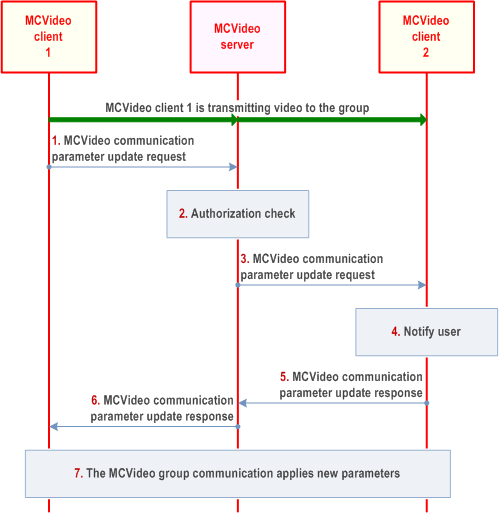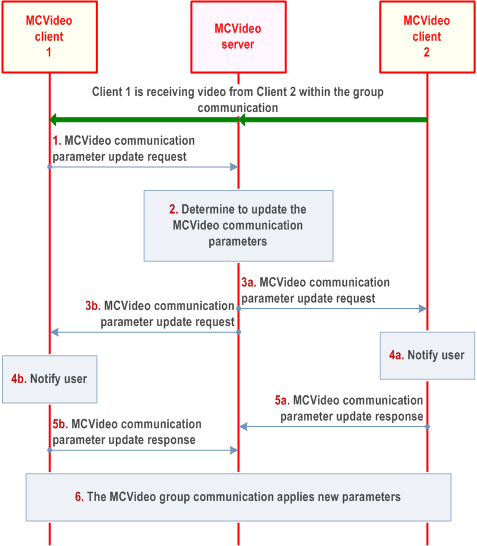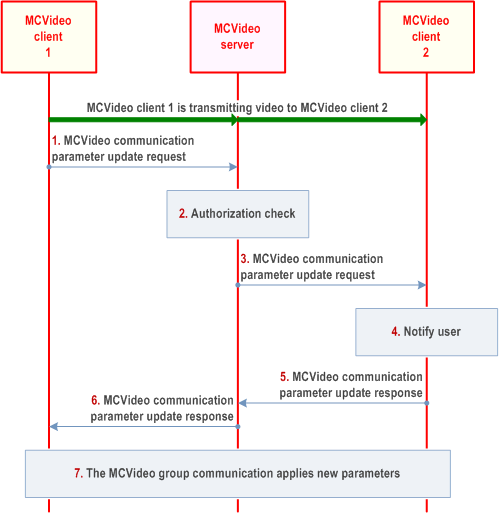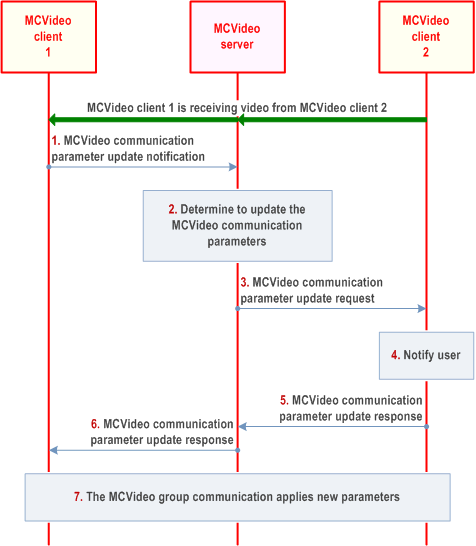Content for TS 23.281 Word version: 19.2.0
1…
5…
6…
7…
7.1.2.3…
7.1.2.3.1.2…
7.1.2.3.2…
7.1.2.4…
7.1.2.5.2…
7.1.3…
7.2…
7.2.2.3…
7.2.2.4…
7.2.3…
7.3…
7.4…
7.4.3…
7.5…
7.5.2.3…
7.6…
7.7…
7.7.1.3…
7.7.1.3.2A…
7.7.1.3.4…
7.7.1.3.6…
7.7.2…
7.7.2.7…
7.7.2.9…
7.8…
7.11…
7.17…
7.19…
7.19.2.8…
7.19.3…
7.19.3.1.4…
7.19.3.2…
7.19.3.2.3…
7.19.3.2.6…
A…
7.17 MCVideo adaptation during MCVideo communication
7.17.1 General
7.17.2 Information flows for MCVideo adaptation
7.17.2.1 MCVideo communication parameter update request
7.17.2.2 MCVideo communication parameter update response
7.17.3 MCVideo adaptation procedure
7.17.3.1 MCVideo adaptation during group communication procedure - transmitting client triggered
7.17.3.2 MCVideo adaptation during group communication procedure - receiving user triggered
7.17.3.3 MCVideo adaptation during private communication procedure - transmitting client triggered
7.17.3.4 MCVideo adaptation during group communication procedure - receiving user triggered
7.18 Use of ProSe capabilities in off-network MCVideo communications
7.18.1 General
7.18.2 Procedures
...
...
7.17 MCVideo adaptation during MCVideo communication |R15| p. 169
7.17.1 General p. 169
The MCVideo adaption is used by an authorized MCVideo client to automatically change the video communication parameters including codec, resolution etc. according to the network conditions changes detected through such as packet loss or packet delay.
7.17.2 Information flows for MCVideo adaptation p. 169
7.17.2.1 MCVideo communication parameter update request p. 169
Table 7.17.2.1-1 describes the information flow for the MCVideo communication parameter update request from MCVideo client to MCVideo sever and from MCVideo server to MCVideo client.
| Information Element | Status | Description |
|---|---|---|
| MCVideo ID | M | The identity of the MCVideo user requesting to update MCVideo communication parameter |
| MCVideo group ID | O (see Note) | The identity of the MCVideo group which the MCVideo communication parameter to be updated (Only used in group communication) |
| MCVideo ID | O (see Note) | The identity of the MCVideo user ID which the MCVideo communication parameter to be updated (Only used in private communication) |
| SDP | M | The new SDP including codec, resolution, frame rate and etc. for MCVideo communication |
|
NOTE:
At least one of these information elements shall be present
|
||
7.17.2.2 MCVideo communication parameter update response p. 170
Table 7.17.2.2-1 describes the information flow for the MCVideo communication parameter update response from the MCVideo server to the MCVideo client and from MCVideo client to MCVideo server.
| Information Element | Status | Description |
|---|---|---|
| Result | M | Indicates success or failure |
7.17.3 MCVideo adaptation procedure p. 170
7.17.3.1 MCVideo adaptation during group communication procedure - transmitting client triggered p. 170
Figure 7.17.3.1-1 describes the procedure for transmitting MCVideo client triggered MCVideo communication parameters update in on-network. For simplicity, only one receiving user is shown in the figure. This procedure is applicable to only one MCVideo transmitting user during the MCVideo group call, e.g., broadcast group call.
Pre-conditions:
- MCVideo client 1 and MCVideo client 2 are the group communication participants, and the MCVideo client 1 is transmitting video in the MCVideo group communication.

Step 1.
MCVideo client 1 sends MCVideo communication parameter update request to the MCVideo server to adjust the video communication parameters due to network conditions changes detected, e.g., through packet loss or packet delay. The new parameters including codec, resolution, frame rate and etc. are included.
Step 2.
MCVideo server checks whether the MCVideo user of MCVideo client 1 has the authorization to update the MCVideo communication parameters.
Step 3.
When authorized, MCVideo server sends the MCVideo communication parameter update request to the MCVideo client 2.
Step 4.
The MCVideo user of MCVideo client 2 is notified about the changes of MCVideo communication parameters.
Step 5.
The MCVideo client 2 accepts the request, and sends the MCVideo communication parameter update response to the MCVideo server.
Step 6.
The MCVideo server sends the MCVideo communication parameter update response to the MCVideo client 1 with the result.
Step 7.
Then, the MCVideo group communication applies the new MCVideo communication parameters.
7.17.3.2 MCVideo adaptation during group communication procedure - receiving user triggered p. 171
Figure 7.17.3.2-1 describes the procedure for MCVideo server initiated MCVideo communication parameters update in on-network. For simplicity, only one receiving user is shown in the figure. This procedure is applicable to only one MCVideo transmitting user during the MCVideo group call e.g., broadcast group call.
Pre-conditions:
- MCVideo cient 1 and MCVideo client 2 are the group communication participants. MCVideo client 2 is transmitting video, and MCVideo client 1 is receiving video.

Step 1.
MCVideo client 1 sends MCVideo communication parameter update request to the MCVideo server to request the video communication parameters due to network conditions changes detected, e.g., through packet loss. The expected parameters including codec, resolution, frame rate and etc. are included.
Step 2.
MCVideo server may receive a multitude of notifications from the receiving users. The MCVideo server performs authorization check and determines to update the MCVideo communication parameters according to the received notifications.
Step 3.
When authorized, MCVideo server sends the MCVideo communication parameter update request to the MCVideo client 2.
Step 4.
The MCVideo users of MCVideo client 1 and MCVideo client are notified about the changes of MCVideo communication parameters.
Step 5.
The MCVideo client 1 and MCVideo client 2 accepts the request, and sends the MCVideo communication parameter update response to the MCVideo server.
Step 6.
Then, the MCVideo group communication applies the new MCVideo communication parameters.
7.17.3.3 MCVideo adaptation during private communication procedure - transmitting client triggered p. 172
Figure 7.17.3.3-1 describes the procedure for transmitting MCVideo client initiated MCVideo communication parameters update in on-network. This procedure is applicable to the video push and video pull.
Pre-conditions:
- The private communication is ongoing between MCVideo cient 1 and MCVideo client 2, and MCVideo client 1 is transmitting video to MCVideo client 2.

Step 1.
MCVideo client 1 sends MCVideo communication parameter update request to the MCVideo server to adjust the video communication parameters due to network conditions changes detected, e.g., through packet loss. The new parameters including codec, resolution, frame rate and etc. are included.
Step 2.
MCVideo server checks whether the MCVideo user of MCVideo client 1 has the authorization to update the MCVideo communication parameters.
Step 3.
When authorized, MCVideo server sends the MCVideo communication parameter update request to the MCVideo client 2.
Step 4.
The MCVideo user of MCVideo client 2 is notified about the changes of MCVideo communication parameters.
Step 5.
The MCVideo client 2 accepts the request, and sends the MCVideo communication parameter update response to the MCVideo server.
Step 6.
The MCVideo server sends the MCVideo communication parameter update response to the MCVideo client 1 with the result.
Step 7.
Then, the MCVideo communication applies the new MCVideo communication parameters.
7.17.3.4 MCVideo adaptation during group communication procedure - receiving user triggered p. 173
Figure 7.17.3.4-1 describes the procedure for receiving user initiated MCVideo communication parameters update in on-network. This procedure is applicable in video push and video pull.
Pre-conditions:
- The private communication is ongoing between MCVideo cient 1 and MCVideo client 2, and the MCVideo client 1 is receiving video from MCVideo client 2.

Step 1.
MCVideo client 1 sends MCVideo communication parameter update request to the MCVideo server to request the video communication parameters due to network conditions changes detected, e.g., through packet loss. The expected parameters including codec, resolution, frame rate and etc. are included.
Step 2.
MCVideo server checks whether the MCVideo user of MCVideo client 1 has the authorization to update the MCVideo communication parameters.
Step 3.
When authorized, MCVideo server sends the MCVideo communication parameter update request to the MCVideo client 2.
Step 4.
The MCVideo user of MCVideo client 2 is notified about the request of MCVideo communication parameters update.
Step 5.
The MCVideo client 2 accepts the request, and sends the MCVideo communication parameter update response to the MCVideo server.
Step 6.
The MCVideo server sends the MCVideo communication parameter update response to the MCVideo client 1 with the result.
Step 7.
Then, the MCVideo communication applies the new MCVideo communication parameters.
7.18 Use of ProSe capabilities in off-network MCVideo communications |R17| p. 174
7.18.1 General p. 174
When an MCVideo user using a ProSe-enabled UE wants to communicate with a specific MCVideo group or MCVideo user using ProSe capabilities, the MCVideo client enables the use of the ProSe layer procedures for public safety, as specified in TS 23.303.
For an off-network MCVideo group communication, the MCVideo client obtains configuration data such as the user info ID of the calling MCVideo user and the ProSe Group IP multicast address and ProSe Layer-2 Group ID associated to the target MCVideo group (as described in clause 8.1.3.2 of TS 23.280), and provides it to the ProSe layer. The ProSe Layer-2 Group ID of the target MCVideo group may be used by the ProSe layer as the target group info and the discovery group ID (defined in TS 23.303).
Prior to initiating an off-network MCVideo group communication, a group member discovery procedure may be initiated to identify whether other members of the target MCVideo group are in the proximity of the calling MCVideo user, as described in the ProSe direct discovery for public safety use procedure in TS 23.303. The off-network MCVideo group communication using the ProSe capability is based on the one-to-many ProSe direct communication procedure for public safety use described in TS 23.303.
For an off-network one-to-one MCVideo communication, the MCVideo client obtains configuration data such as the ProSe discovery group ID and user info ID of the target MCVideo user from the "List of user(s) who can be called in MCVideo private call" in the MCVideo user profile and requests the IP address of the MCVideo UE associated with the target MCVideo user from the ProSe layer.
The MCVideo client enables the ProSe layer to determine the IP address for the communication with the target MCVideo UE by providing the ProSe discovery group ID and user info ID (as defined in TS 23.303) associated to the target MCVideo user. This may trigger the ProSe direct discovery for public safety use procedure to identify whether the target MCVideo user is in the proximity of the calling MCVideo user. The user info ID of the target MCVideo user is used by the ProSe layer as the target info (as defined in TS 23.303).
The ProSe layer can then provide the IP address related to the target MCVideo user to the MCVideo client to initiate the off-network one-to-one MCVideo communication based on the one-to-one ProSe direct communication procedure described in TS 23.303.
7.18.2 Procedures p. 175
The off-network MCVideo communication procedures using the ProSe capabilities are described within the corresponding clauses of each MCVideo capability, e.g. group communication procedures for off-network are described in clause 7.1.3 and private communication procedures for off-network are described in clause 7.2.3.